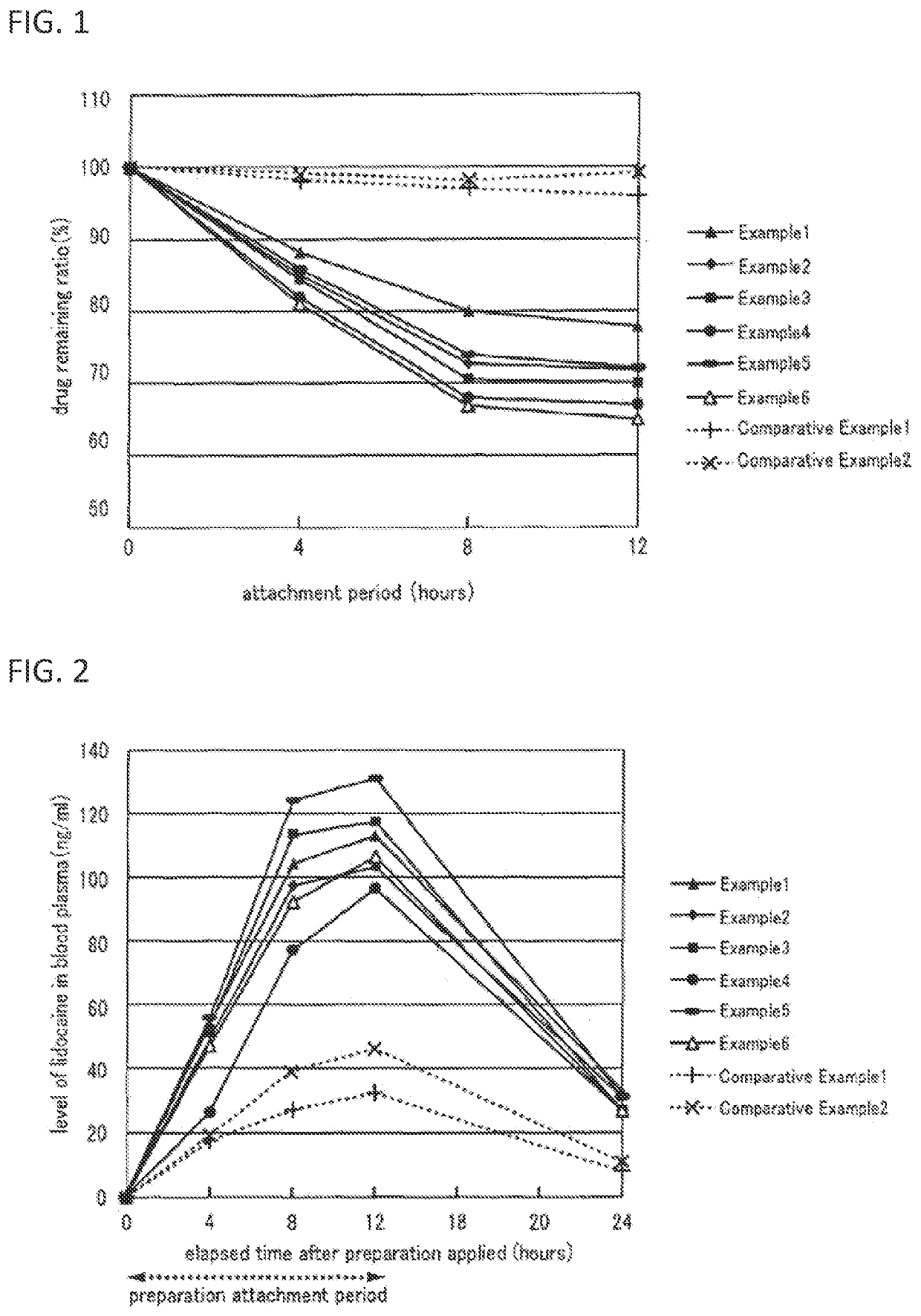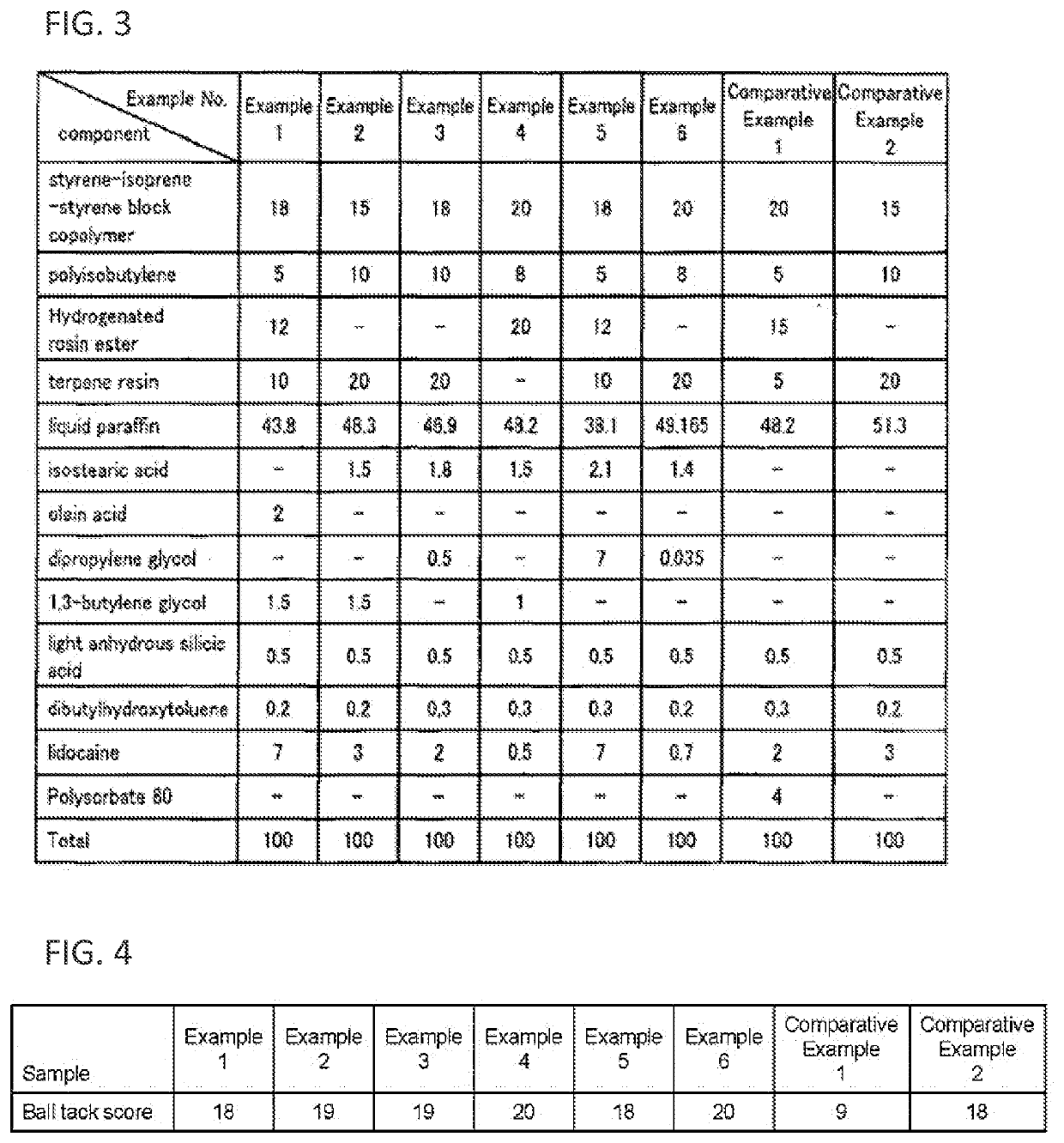Non-aqueous patch
a patch and non-aqueous technology, applied in the field of non-aqueous patches, can solve the problems of changing adhesion and physical properties, difficult to attach aqueous base patches to the skin for a long time, and poor compatibility of aqueous base patches with the skin, so as to achieve rapid increase in blood levels, efficiency and safety, and less side effects
- Summary
- Abstract
- Description
- Claims
- Application Information
AI Technical Summary
Benefits of technology
Problems solved by technology
Method used
Image
Examples
example 1
[0031]Styrene-isoprene-styrene block copolymer (“Kraton D1161”, produced by Kraton JSR Elastomers K.K.): 18 mass %
[0032]Polyisobutylene (trade name “Himol 6H”, produced by JX Nippon Oil & Energy Corporation): 5 mass %
[0033]Hydrogenated rosin ester (trade name “Pinecrystal KE-311”, produced by Arakawa Chemical Industries, Ltd.): 12 mass %
[0034]Terpene resin (trade name “YS resin 1150N”, produced by Yasuhara Chemical Co., Ltd.): 10 mass %
[0035]Lidocaine: 7 mass %
[0036]1,3-butylene glycol (produced by Daicel Chemical Industries, Ltd.): 1.5 mass %
[0037]Oleic acid (“Purified Oleic Acid”, produced by NOF Corporation): 2 mass %
[0038]Liquid paraffin (trade name “Hicall”, produced by Kaneda Corporation): 43.8 mass %
[0039]Light anhydrous silicic acid (trade name “Sylysia 350”, produced by Fuji Silysia Chemical Ltd.): 0.5 mass %
[0040]Dibutylhydroxytoluene (trade name “BHT”, produced by Honshu Chemical Industry Co., Ltd.): 0.2 mass %
[0041]The production method using these materials according to...
example 2
[0042]Styrene-isoprene-styrene block copolymer (“Kraton D1161”, produced by Kraton JSR Elastomers K.K.): 15 mass %
[0043]Polyisobutylene (trade name “Himol 6H”, produced by JX Nippon Oil & Energy Corporation): 10 mass %
[0044]Terpene resin (trade name “YS resin 1150N”, produced by Yasuhara Chemical Co., Ltd.): 20 mass %
[0045]Liquid paraffin (trade name “Hicall”, produced by Kaneda Corporation): 48.3 mass %
[0046]Isostearic acid (produced by Kokyu Alcohol Kogyo Co., Ltd.): 1.5 mass %
[0047]Lidocaine: 3 mass %
[0048]1,3-butylene glycol (produced by Daicel Chemical Industries, Ltd.): 1.5 mass %
[0049]Light anhydrous silicic acid (trade name “Sylysia 350”, produced by Fuji Silysia Chemical Ltd.): 0.5 mass %
[0050]Dibutylhydroxytoluene (trade name “BHT”, produced by Honshu Chemical Industry Co., Ltd.): 0.2 mass %
[0051]The production method using these materials according to the above formulation was as follows. The styrene-isoprene-styrene block copolymer, polyisobutylene, terpene resin, light ...
example 3
[0052]Styrene-isoprene-styrene block copolymer (“Kraton D1161”, produced by Kraton JSR Elastomers K.K.): 18 mass %
[0053]Polyisobutylene (trade name “Himol 6H”, produced by JX Nippon Oil & Energy Corporation): 10 mass %
[0054]Terpene resin (trade name “YS resin 1150N”, produced by Yasuhara Chemical Co., Ltd.): 20 mass %
[0055]Liquid paraffin (trade name “Hicall”, produced by Kaneda Corporation): 46.9 mass %
[0056]Isostearic acid (produced by Kokyu Alcohol Kogyo Co., Ltd.): 1.8 mass %
[0057]Dipropylene glycol (produced by NOF Corporation): 0.5 mass %
[0058]Lidocaine: 2 mass %
[0059]Light anhydrous silicic acid (trade name “Sylysia 350”, produced by Fuji Silysia Chemical Ltd.): 0.5 mass %
[0060]Dibutylhydroxytoluene (trade name “BHT”, produced by Honshu Chemical Industry Co., Ltd.): 0.3 mass %
[0061]The production method using these materials according to the above formulation was as follows. The styrene-isoprene-styrene block copolymer, polyisobutylene, terpene resin, light anhydrous silicic ...
PUM
| Property | Measurement | Unit |
|---|---|---|
| Fraction | aaaaa | aaaaa |
| Time | aaaaa | aaaaa |
| Percent by mass | aaaaa | aaaaa |
Abstract
Description
Claims
Application Information
 Login to view more
Login to view more - R&D Engineer
- R&D Manager
- IP Professional
- Industry Leading Data Capabilities
- Powerful AI technology
- Patent DNA Extraction
Browse by: Latest US Patents, China's latest patents, Technical Efficacy Thesaurus, Application Domain, Technology Topic.
© 2024 PatSnap. All rights reserved.Legal|Privacy policy|Modern Slavery Act Transparency Statement|Sitemap


